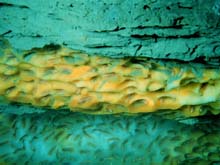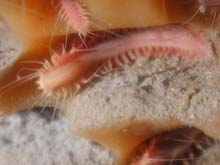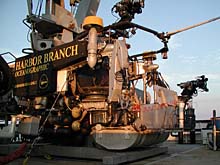
The Johnson Sea-Link submersible resting on deck between dives. Click image for a larger view and expanded caption. Click image for a larger view.
Mission Plan
Chuck Fisher, Penn State University
Patty Sobecky, Georgia Institute of Technology
Craig Young, University of Oregon
An interdisciplinary team of scientists is using Harbor Branch Oceanographic Institute’s Johnson Sea-Link submersible on six different expeditions to explore and study the communities of animals found around deep-sea oil seeps in the Gulf of Mexico. The team of scientists, which includes ecologists, larval biologists, physiologists, microbiologists, geologists, geochemists and oceanographers, hail from Pennsylvania State University, University of Oregon, Louisiana State University, University of Virginia, Georgia Institute of Technology, University of Georgia, University of Missouri and Texas A & M University..
Together, they will search the animal communities associated with oil and gas seepage. During the expedition, they will conduct experiments and collect samples to describe the lush communities that thrive in the absence of sunlight. Leg 1 and Leg 2 of these expeditions have already been completed. Leg 3 is scheduled for October 6–19, 2002. The last three legs of the expedition will occur between February and October of 2003.
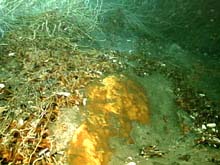
Tubeworms and mussels on top of a hydrate mound. The yellowish methane hydrate provides a source of methane for the mussels living on top of them. Click image for larger view.
Cold-seep Communities
The cold-seep communities of the deep Gulf of Mexico were first discovered in the mid-1980s. The discovery excited scientists because the communities were similar to deep-sea hydrothermal vent communities of the Galapagos Rift in many ways. However, the scientists soon determined that though the animals at the vents and seeps were often closely related and looked quite similar, they had very different lifestyles. For example, at the hydrothermal vents, the tubeworms grow very fast and die young. In contrast, the tubeworms at cold seeps grow very slowly and can live for at least 200 years! Scientists also found that, unlike the known vent mussels, some of the seep mussels use methane—not sulfide—as their primary energy source. Additionally, scientists have recently discovered that the cold seep tubeworms grow “roots” deep into the sediment and use them to bring up the dissolved gases they need to grow, making these bizarre 6-foot worms more like plants than animals in many ways.
During these expeditions, the scientists will be studying the growth, anatomy, and physiology of the tubeworms. Tubeworm reproduction is one of the main focuses of the expedition because some scientists believe that they may produce more young over the course of their lives than any other animal in the ocean! The scientists also will be studying the feeding behavior, physiology, and reproduction of the mussels and several other inhabitants of the seeps. Meanwhile, microbiologists will be collecting and studying the microorganisms that inhabit oil- and gas-filled sediments, solid methane ice, and hypersaline pools on the seafloor
The first leg of the mission took place from June 15 - 30, 2002. This mission had several priorities. First, the team tested new equipment that had been specially built for the mission ( e.g., the "Big sucker" and "bush-stainer") and set up a variety of experiments that would be re-visited on later missions. Second, they collected a variety of samples, including 1) mussels and associated animals, 2) intact tubeworm aggregations, 3) push cores full of mud and bacteria, 4) water samples for microbial and chemical analysis, and 5) any other strange animals encountered while diving. Between dives, the team used traps dropped from the boat (attached to floats) to collect animals from non-seep areas. Finally, the team explored new areas. Divers described the communities they saw and collected samples that would help them describe new species and perhaps even new types of communities. The team was able to accomplish most of its tasks despite bad weather and engine problems, which forced them to cancel 11 of the 26 planned dives..
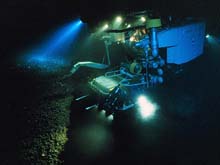
The Johnson Sea-Link floating on the top of the brine pool. The hypersaline conditions of the brine pool make it dense enough for the submersible to land on its surface! The “shore line” of the pool (with the spotlight shining on it) is composed of the mussel Bathymodiolis childressi. Click image for larger view.
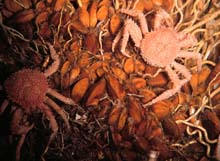
Mussels and tubeworms growing together at a seep site. At first glance, these communities look very similar to those found around hydrothermal vents. Once they were better studied, however, scientists realized that they were different in many ways. Click image for larger view.
The second leg of the mission took place from July 2 - 23, 2002. During this leg, microbiologists, geochemists and biological oceanographers collected samples from the brine pool, using a piece of equipment called the “brine trapper,” which is used to collect brine and sediment samples at discrete depths. In addition, they set out to collect gas hydrate samples (“fire ice”) from sites that were visited last year and some new sites as well.
The team also collected sediments and microbial mats from all of the dive sites to use in many different scientific experiments onboard the ship and back at the laboratory. Between sub dives, they also collected water samples and sediments using gravity cores and box cores. The team was fortunate to have excellent weather, and had to cancel only seven of the 36 scheduled dives because of bad weather or submersible battery charger
The third leg of this mission will take place from October 6-19, 2002, with scientists and students from eight different institutions in the U.S., Norway, England, Portugal and Spain participating. The major goal of this cruise is to study the reproduction and embryology of seep animals, including mussels, clams, snails, crustaceans, tubeworms and several other kinds of worms.
One of the major surprises of deep-sea biology over the past 50 years was the discovery that many deep, cold-water species breed during only one season of the year. Seasonal breeding is common in shallow water, but it was not expected in the deep sea, where seasonal changes are not obvious.
This expedition and subsequent ones will focus on determining the signals that tell deep-sea animals when it is time to reproduce. The team also will be trapping animals to study feeding biology, and will collect more tube worm bushes for studies of community structure and diversity. The team also will collect and rear the microscopic larvae (swimming babies) of several cold-seep animals, will collect sediment cores for studies of microscopic animals that live between the sand grains, and will seek the larvae of seep animals in plankton samples. Divers will venture to areas never before explored.
2003 Missions
The last three legs of the mission will occur in 2003. Then, we will complete the many different experiments started on the first three legs, and explore variation in the communities and the animals at different times of the year. We will continue to visit and explore new areas that have never been visited before.
Sign up for the Ocean Explorer E-mail Update List.
























